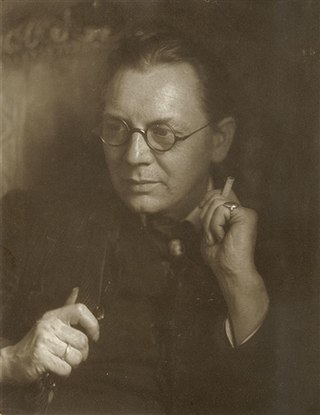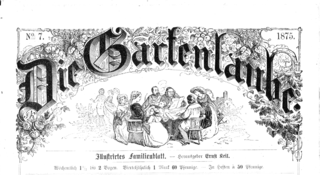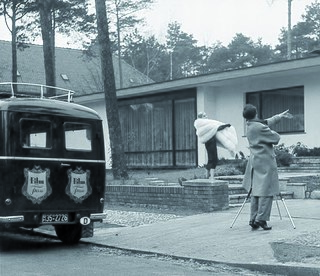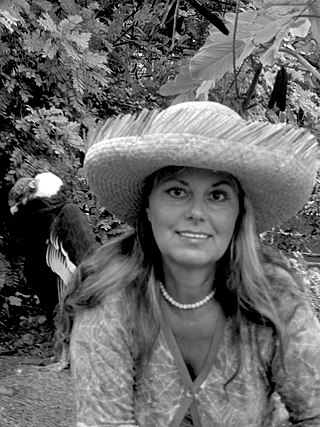
Ralf Winkler, alias A. R. Penck, who also used the pseudonyms Mike Hammer, T. M., Mickey Spilane, Theodor Marx, "a. Y." or just "Y" was a German painter, printmaker, sculptor, and jazz drummer. A neo-expressionist, he became known for his visual style, reminiscent of the influence of primitive art.

Hugo Erfurth was a German photographer known for his portraits of celebrities and cultural figures of the early twentieth century.
Stefan Roloff is a German-American painter, video artist, filmmaker, and pioneer of digital video and photography, living and working in New York and Berlin. Roloff's documentary, The Red Orchestra, a portrait of his late father, Helmut Roloff, an anti-Nazi resistance fighter, was nominated for Best Foreign Film 2005 by the US Women Critics Circle.
The Deutsche Fotothek is a picture library in Dresden, Germany, located in the Saxon State Library. It holds more than two million images. Its strengths are in art, architecture, music, geography, technology, the economy, and the Saxony region. Its collection came from institutions, companies, and individuals such as Hermann Krone.

Pigeon photography is an aerial photography technique invented in 1907 by the German apothecary Julius Neubronner, who also used pigeons to deliver medications. A homing pigeon was fitted with an aluminium breast harness to which a lightweight time-delayed miniature camera could be attached. Neubronner's German patent application was initially rejected, but was granted in December 1908 after he produced authenticated photographs taken by his pigeons. He publicized the technique at the 1909 Dresden International Photographic Exhibition, and sold some images as postcards at the Frankfurt International Aviation Exhibition and at the 1910 and 1911 Paris Air Shows.

Tošo Dabac was a Croatian photographer of international renown. Although his work was often exhibited and prized abroad, Dabac spent nearly his entire working career in Zagreb. While he worked on many different kinds of publications throughout his career, he is primarily notable for his black-and-white photographs of Zagreb street life during the Great Depression era.

The Berlinische Galerie is a museum of modern art, photography and architecture in Berlin. It is located in Kreuzberg, on Alte Jakobstraße, not far from the Jewish Museum. The Berlinische Galerie collects art created in Berlin since 1870 with a regional and international focus. Since September 2010, the museum's director has been the art historian Thomas Köhler, until then deputy director, succeeding Jörn Merkert.

Die Gartenlaube – Illustriertes Familienblatt was the first successful mass-circulation German newspaper and a forerunner of all modern magazines. It was founded by publisher Ernst Keil and editor Ferdinand Stolle in Leipzig, Kingdom of Saxony in 1853. Their objective was to reach and enlighten the whole family, especially in the German middle classes, with a mixture of current events, essays on the natural sciences, biographical sketches, short stories, poetry, and full-page illustrations.

Arno Fischer was a German photographer and university teacher.

John P. Jacob is an American curator. He grew up in Italy and Venezuela, graduated from the Collegiate School (1975) in New York City, and studied at the University of Chicago before earning a BA in human ecology from the College of the Atlantic (1981) and an MA in art history from Indiana University (1994).
Stefan Heyne is a German photographer and stage designer. He lives and works in Berlin.

Evelyn Richter was a German art photographer known primarily for social documentary photography work in East Germany. She is notable for her black & white photography in which she documented working-class life, and which often showed influences of Dadaism and futurism. Her photography is focused on people in everyday life, including children, workers, artists and musicians.

Cornelia Schleime is a German painter, performer, filmmaker and author. Born in East Berlin under the GDR, she studied painting and graphic arts at the Dresden Academy of Fine Arts before becoming a member of the underground art scene.

Franz Christian Gundlach was a German photographer, gallery owner, collector, curator and founder.
Hermann Claasen was a German photographer.

The German Society for Photography is a German photography organisation, based in Cologne. It is concerned with the application of photography in art, science, education, journalism, economics and politics in cultural contexts.

Herlinde Koelbl is a German photographic artist, author and documentary filmer.

Gundula Schulze Eldowy is a German photographer. In addition to her photographic and film work, she has created stories, poems, essays, sound collages and songs.

Thomas Kellner is a German fine-art photographer, lecturer and curator. He became known above all for his large-format photographs of famous architectural monuments, which, through many individual images and a shifted camera perspective, look like "photo mosaics".
Sibylle was a bimonthly fashion magazine that was published in East Germany and then in Germany from 1956 to 1995. The magazine was subtitled Zeitschrift für Mode und Kultur. It is known as the most famous fashion magazine of East Germany and was called Vogue of East Germany.















